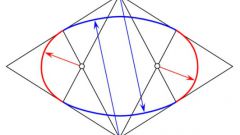Instruction
1
A figure that can be drawn with one line without lifting the hand from the paper, called unicursal. Not all geometric shapes have this property.
2
It is assumed that the given figure consists of points connected by straight or curved segments. Therefore, at each of these points converges to a certain number of segments. Such figures in mathematics called graphs.
3
If the point converges an even number of segments, and itself such a point is called an even vertex. If the number of segments is odd, then the vertex is called odd. For example, the square in which both diagonals conducted, has four odd nodes and one even — at the point of intersection of the diagonals.
4
Have a cut, by definition, two ends, and hence it always connects two vertices. Therefore, summing all incoming segments for all vertices of the graph can only be an even number. Therefore, whatever count, odd vertices in it will always be an even number (including zero).
5
If the graph has no odd vertices, it is always possible to draw without lifting your hands from the paper. Still, what tops to start.
If the odd vertices, then this graph is also unicursal. The path must begin at one odd vertex and end in another of them.
The figure, which is odd vertices four or more, not unicursal, and without repetition of the lines to draw it will fail. For example, the same square with the diagonals not unicursal as it has four odd vertices. But the square with one diagonal or "envelope" — a square with diagonals and the "cap" — you can draw a single line.
If the odd vertices, then this graph is also unicursal. The path must begin at one odd vertex and end in another of them.
The figure, which is odd vertices four or more, not unicursal, and without repetition of the lines to draw it will fail. For example, the same square with the diagonals not unicursal as it has four odd vertices. But the square with one diagonal or "envelope" — a square with diagonals and the "cap" — you can draw a single line.
6
To solve the problem, you need to imagine that each of the line disappears from the figure the second time will go. Therefore, portraying unicursal figure, be sure that the rest of the work is not divided into unrelated parts. If this happens, bring the matter to an end will not happen.

